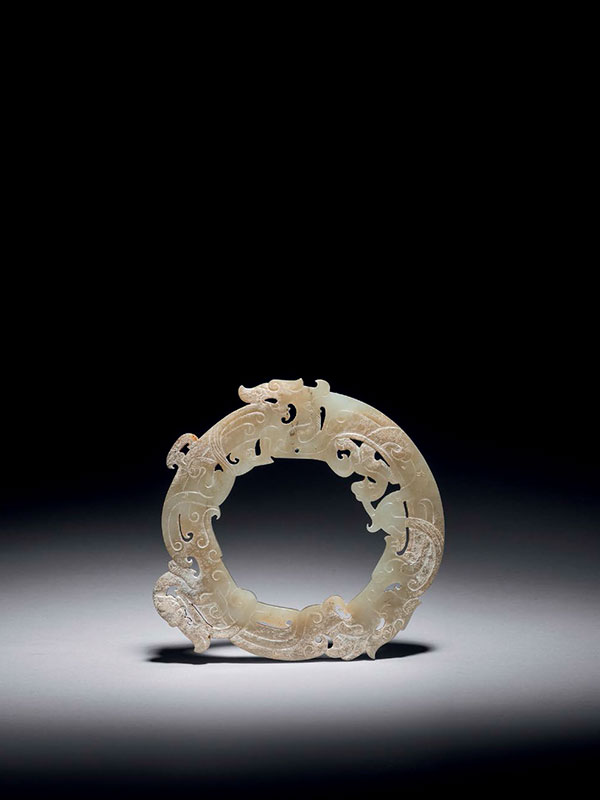Circular disc huan, with dragons
A jade bi disc of circular form with a round aperture in the centre. Each side of the disc is carved in low relief and openwork design with chi dragons of different sizes entwined with each other. Their sinuous bodies with sprawling limbs and elongated tails cover the entire disc. The stone is of predominantly yellowish celadon tone with areas of brown inclusions all over and a few white veins. Some calcified areas are visible. A small hole drilled underneath one of the dragonheads has been filled with a bronze fitting, which has corroded to a green colour.
This exquisitely carved circular jade huan was originally a component part of a set of pendants, strung in rows with beads and huang of arched form. Together they would have hung from the waist or the shoulders, creating a tingling sound when worn. Such jade pendants were considered emblems of virtue and were recognised as a sign of rank. A jade huan of similar size and closely comparable in design with two dragons in openwork carving, dated to the Warring States period (475 – 221 BC), was excavated from Tomb no. 1 at Shangwangcun, Linzi, Shandong province and is now in the Zibo Museum at Shandong (fig. 1).[1] Two comparable jade huan with dragons carved in relief and in openwork design, and forming part of a pendant set of jade ornaments, were excavated from the tomb of the King of Nanyue. These can be dated to the Western Han dynasty (206 BC- 9 AD), and are now in the eponymous museum in Guangzhou.[2] A smaller Han dynasty circular jade pendant with closely comparable dragon carving in relief is in the collection of the Palace Museum, Beijing.[3] A further comparable jade pendant with openwork design of kui dragons, excavated from the tomb of King Cuo, of the State of Zhongshan of the Warring States period (475 – 221 BC), is in the collection of the Hebei Provincial Museum.[4]
- Gu, Fang ed. Complete Collection of Unearthed Jades in China- vol. 4 Shandong, Ke xue chu ban she, Beijing, 2005 p. 196
- Lam, P. Y. K. ed. Jades from the Tomb of the King of Nanyue, Guangzhou, Hong Kong, 1991, pls. 143, 146, 149-151
- Compendium of Collections in the Palace Museum, Jade, vol. 4- Han, Wei, Jin, Southern and Northern Dynasties, The Forbidden City Publishing House, Beijing, 2011, no. 209, p. 160
- Liu, Jiansheng ed. Warring States Treasures- Cultural Relics from the State of Zhongshan, Hebei Province, Provisional Urban Council of Hong Kong, 1999, no. 67, p. 172
透雕龍紋環形玉珮
戰國晚期至漢代 西元前三世紀 – 西元二世紀
徑:10.6 公分
圓形青黃玉環,質細半透明,器面散佈深淺不一的褐絲紋與暗褐色沁,中孔,雙面鏤雕螭龍及雲氣紋,陰線細刻捲雲紋。螭龍作大跨步騰飛狀,龍首翹望於玉環外側,角上端前折,口微張,吻上翹,呈典型 戰國晚期至漢代龍紋造型,整體極富動感。環上側內緣鑽一小孔,存留銅鏽少許,顯示此環原以銅鏈相 接。山東省淄博市臨淄區商王村一號墓出土一件雙龍紋黃玉環,其部分透雕設計與本品相似,現藏於淄 博市博物館。另一件戰國玉環於1977年河北省中山王嚳墓出土,亦為透雕龍紋設計。類似設計亦可見 於西漢南越王墓出土成組玉珮中,包含兩件形制極為相似的透雕螭龍紋環。北京故宮博物院亦藏有一件 小型漢代螭龍紋環形玉珮,可茲比較。

